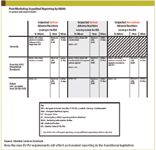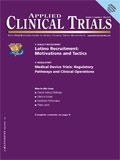Two Months and Counting on EU Pharmacovigilance Implementation Deadline
The EMA issued seven draft guidances of the 16 modules for good pharmacovigilance practice in February. There has been confusion and concern among sponsors over how to implement a legislation with no clear guidance from the EMA.
July 21, 2012 seemed far away back in December 2010 when the EU published its latest regulation and directive for the conduct of pharmacovigilance within the member states.
However, since that date 16 months ago, there has been confusion and concern among sponsors, or marketing authorization holders (MAH) as they are known in the EU, over how to implement a legislation with no clear guidance from the EMA. The EMA issued seven draft guidances of the 16 modules for good pharmacovigilance practice in February. The EMA assured industry that these seven modules would be finalized before July, but did not make a firm date. The remaining nine will be published by the end of the year.
To be clear, according to Sonia Araujo, London-based Manager of Product Management for Medidata Solutions Worldwide, the legislation implementation is incremental with clear transitional provisions.
Patient participation
The high level objective of the legislation is to promote and protect public health by reducing the burden of adverse drug reactions and optimizing the use of drug therapy. However, as Araujo explained in a recent interview with Applied Clinical Trials, "The expected increased public participation and exposure is both brilliant and daunting." Patients will be able to report adverse drug reactions directly to national competent authorities through web portals, playing an active role in identifying adverse reaction patterns. Additionally, patients will be able to attend public hearings on medicines, and patient representatives will be included in the newly created pharmacovigilance and risk assessment committee (PRAC).

How the new EU PV requirements will affect post-market reporting in the transitional legislation.
Adverse drug reactions
To put adverse drug reactions (ADRs)in perspective, the following statistics show their impact in the EU:
- 5% of all hospital admissions are due to an ADR
- 5% of all hospital patients experience an ADR
- ADRs are the fifth most common cause of hospital death
- ADRs cause an estimated 197,000 deaths per year
- The total cost to society of ADRs is €79 billion
Obviously, these facts from the European Commission circa 2008, are not specific to clinical trials, however the impact to the earlier phases of drug development is implied. What the new legislation emphasizes, noted Araujo, is a change for drug makers to rethink, redesign, and redeploy the entire life cycle of drug products marketed in the EU.
"The new provisions will likely affect industry and regulatory practices on a global basis. ICH (the International Conference on Harmonization of Technical Requirements for the Registration of Pharmaceuticals for Human Use) is almost certain to become involved as one of its three key constituencies rewrites its rule book. Pharmacovigilance is poised to become a key consideration starting with the very earliest phases of drug development, not an addendum that may appear sometime after marketing approval has been granted," said Araujo.
Sponsors' perspective
"We will be implementing some provisions before the guidance comes out," predicted Sue Rees, MSc, Head of Pharmacovigilance & Safety Risk Management and EU Qualified Person for Pharmacovigilance, Eisai Europe Ltd., during a webinar sponsored by Applied Clinical Trials in late 2011. Both Rees and Araujo will be presenting in an update to this webinar on June 6 in another free webinar titled "Prepare your Organization Today to Address the New EU PV Legislation." Go to appliedclinicaltrialsonline.com/eupv to register for the live webinar.
Araujo said, "It is a tremendous stress on industry to learn about a thing one day and be ready to fall into place with it the next day. It helps to look forward to the ultimate goal and work backward through the transition."
Take expedited reporting. The ultimate goal will be to report on all suspected adverse reactions to the EMA's EudraVigilance database. The universe of reportable adverse reactions will include all suspected serious adverse reactions that occur worldwide within 15 days, and all suspected non-serious adverse reactions from inside the EU within 90 days. All reporting is to be electronic (i.e., using the industry-standard E2B format).
This ultimate legislative goal is expected to be in place no earlier than the second half of 2015—after EudraVigilance's new functionality is in place and has been independently audited, and the EMA has given the industry six months' notice.
While MAHs will be required to file expedited reports to fewer entities, their data collection burden could increase if they are requested to file expedited reports for suspected nonserious adverse reactions.
The challenge, said Araujo, is that many pharmas continue to rely on manual data collection using paper forms that are faxed to a central office to be assessed, collated, and digitized for reporting. Adding an unknown, but undoubtedly large number of suspected non-serious adverse reactions will only increase expedited reporting volume, stress, and the likelihood of missing reporting deadlines.
One solution is to collect data electronically from the outset. That can significantly reduce or eliminate the costs associated with paper data collection and record storage as well as the associated personnel costs. Electronic data collection also helps to improve data integrity and audit performance, offered Araujo. She concluded: "Pharma firms and software vendors have a pressing need to cooperate on electronic data collection."

Improving Relationships and Diversifying the Site Selection Process
April 17th 2025In this episode of the Applied Clinical Trials Podcast, Liz Beatty, co-founder and chief strategy officer, Inato, discusses a number of topics around site engagement including community-based sites, the role of technology in improving site/sponsor relationships, how increased operational costs are impacting the industry, and more.
Behind the Buzz: Why Clinical Research Leaders Flock to SCOPE Summit
February 7th 2025In this episode, we meet with Micah Lieberman, Executive Conference Director for SCOPE Summit (Summit for Clinical Ops Executives) at Cambridge Innovation Institute. We will dive deep into the critical role of collaboration within the clinical research ecosystem. How do we bring together diverse stakeholders—sponsors, CROs, clinical trial tech innovators, suppliers, patients, sites, advocacy organizations, investors, and non-profits—to share best practices in trial design, program planning, innovation, and clinical operations? We’ll explore why it’s vital for thought leaders to step beyond their own organizations and learn from others, exchanging ideas that drive advancements in clinical research. Additionally, we’ll discuss the pivotal role of scientific conferences like SCOPE Summit in fostering these essential connections and collaborations, helping shape the future of clinical trials. Join us as we uncover how collective wisdom and cross-industry partnerships are transforming the landscape of clinical research.
FDA-Approved Gene Therapy Beqvez Shows Sustained Efficacy, Safety in Long-Term Hemophilia B Trial
April 17th 2025Beqvez (fidanacogene elaparvovec), an FDA-approved one-time gene therapy for hemophilia B, demonstrated sustained factor IX expression, low bleeding rates, and a favorable safety profile over long-term follow-up.